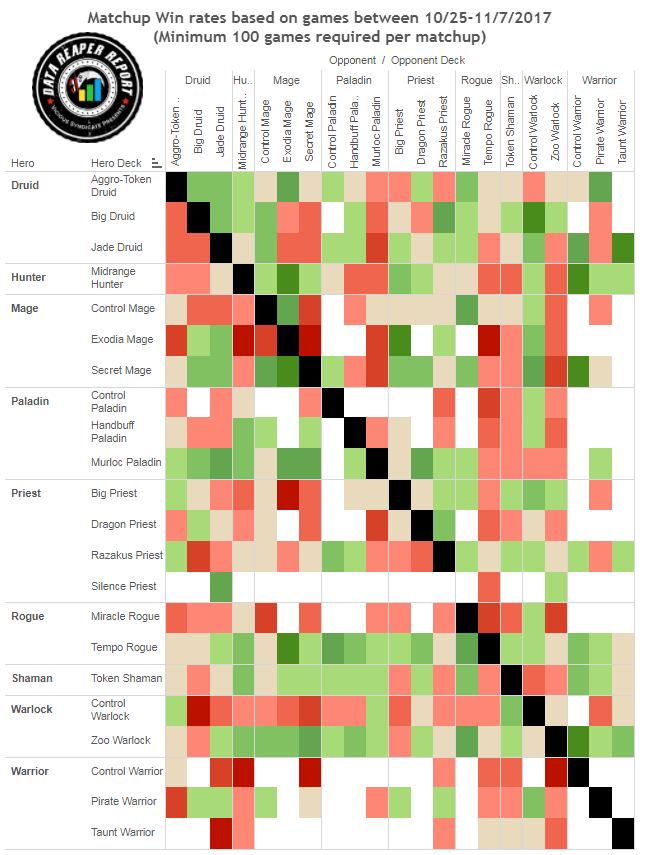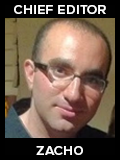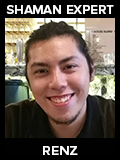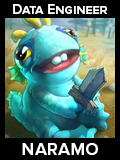
Welcome to the 69th edition of the Data Reaper Report!
Our Data Reaper Project, including the Data Reaper Live has 4,200 active contributors. Without them, this project would not be possible, so we’d like to thank all of our contributors for their help.
Quick Links
Class/Archetype Distribution | Class Frequency | Matchup Winrates | vS Power Rankings | Class Analysis & Decklists | Meta Breaker of the Week | How to Contribute | Credits
Number of Games
| Overall | 75,000 |
| Legend | <500 |
| Ranks 1-5 | 4,000 |
| Ranks 6-10 | 13,000 |
| Ranks 11-15 | 32,000 |
Class/Archetype Distribution
[TABS_PRO id=10998]
Class Frequency
[TABS_PRO id=10999]
Class Frequency Discussion
There are a lot of changes and shifts in the meta, and it starts at the top. Druid has surpassed Rogue in its representation at all levels of play behind its three prevalent archetypes. Internally, Druid is also undergoing dramatic changes, with Big and Aggro-Token Druid significantly rising in play, while Jade Druid is rapidly declining. At the bottleneck to legend. Aggro-Token Druid is the most popular Druid archetype. Some of it has to do with the incentive of piloting a fast deck during the early ladder climb, and some of it has to do with less desirable factors (*cough* bots).
Priest is continuing to decline in play at all skill levels. Most of its archetypes are taking a hit in their play rates. Razakus Priest has been trending down for a while, and Dragon Priest’s numbers are also shrinking. The one exception to that is Big Priest, an archetype that’s actually rising in play, especially at the top end of ladder.
Warlock isn’t showing any signs of stopping when it comes to rise in play, on the back of Zoo’s resurgence after the balance changes. The archetype has now surpassed Jade Druid in its popularity at higher levels of play, and is nearing Razakus Priest’s numbers. Zoo is one of the biggest winners of the balance changes since the reduction in the power levels of other classes’ early game tools means it is now much more effective at winning early game board control, which is crucial to its success.
While Rogue has taken a sharp decline in its play rate at the beginning of the month, Tempo Rogue is still the most popular archetype in the game at all levels of play. It also remains extremely diverse in its builds, with many different takes that are seeing success. Out of all the decks in the current meta, it is the most flexible, with the smallest core of ‘must-include’ cards, which gives it a significant advantage when it comes to dealing with the shifts in the meta that we’re observing.
The other 5 classes are not experiencing many changes, unfortunately. We do notice that Hunter and Paladin have seen a slight uptick in play. Murloc Paladin’s performance against the field is far stronger than its popularity suggests, and while Midrange Hunter isn’t one of the stronger decks out there, it isn’t terrible, and the class tends to see more play at the beginning of the season.

[TABS_PRO id=11000]
vS Power Rankings Discussion
NOTE: Since it’s still very early in the season, and not enough games have been recorded at legend to provide an accurate picture of the meta, we’ve applied legend win rates to the 5-1 table. Early in the month, the 5-1 table best describes the meta at higher levels of play.
NOTE 2: Silence Priest’s play rate has gotten too low for us to place it in the table with enough confidence. If we did, it’d be sitting at Tier 2.
Big Druid stays at the top for another week. This archetype is extremely well positioned in the current meta, with great matchups against the most popular decks. It dominates Razakus Priest and is favored against Jade Druid. In addition, it has an unintuitive capability of handling the slower aggressive decks quite well, such as Tempo Rogue and Zoo Warlock. Its weakness is fast decks that also carry explosive starts, mostly through buffs, such as Aggro-Token Druid and Murloc Paladin. Secret Mage is the other problem matchup, but these decks’ play rates are not enough to offset Big Druid’s advantage against the popular strategies, making it the best deck in the current meta.
Rounding out Tier 1 at higher levels of play is Tempo Rogue and Murloc Paladin. Tempo Rogue is the meta’s most consistent deck, while Murloc Paladin continues to be very underrated by the player base considering how successful it is. Aggro-Token Druid has seen a drop in its win rate which makes a lot of sense considering it is the most popular Druid deck at the bottleneck to legend. This reduces its advantage in previous weeks of being unexpected and catching players off guard. Players are now more mindful of the archetype, both in the mulligan phase and in their deck choices. It is no longer a sleeper deck, but a respected one that is being highly accounted for.
Big Priest and Zoo Warlock have taken slight hits in their win rates, but they are still very strong choices for the current meta. Big Priest is another example why bigger is better in the KFT meta, while Zoo is a great climbing deck that’s particularly powerful at lower skill levels. It still holds its own at the top end of ladder. It has a lot of close matchups against the other popular meta decks, with some of them heavily dependent on card choices from both ends. It’s a very rewarding deck for players who are able to navigate minion choices according to what opponents they are seeing. Secret Mage is the strangest deck at the 50%+ club. Looking at its matchup spread may provide a clue as to why it’s not seeing much play: queuing with it is playing Rock/Paper/Scissors in the worst way. The deck crumbles to aggressive decks that get on the board quickly, and utterly dominates some of the slower decks of the meta. Secret Mage is the strongest counter out there to big decks, because its secret package is highly disruptive to their game plan and their early game passivity allows it to carve out its own game plan without much interference.
Razakus Priest keeps its win rate under 50% for another week, and welcomes its old friend, Jade Druid, to the “I can’t believe this deck is performing this way” club. For Jade Druid, the explanation is simple: The rise of the two other Druid archetypes, both of which have very strong matchups against Jade Druid, is crippling its performance against the field. Jade Druid might be able to summon larger and larger men, but Big Druid skips the larger and larger part and goes straight for the 8/8’s and the 12/12’s. In the current meta, it’s better to go bigger, faster.
Speaking of Razakus Priest Tier 3 memes, the deck is actually showing signs of improvement at higher levels of play, which correlates with the latest shifts in the archetype’s builds. There is currently a disparity between the performance of older builds and new builds, some of which have been quite successful at the end of the last season and the beginning of this one. The key to success with Razakus Priest is adaptation. We’ll give you two examples.
The Pint/Horror combo drops off in its effectiveness once you reach higher levels of play and encounter more decks that carry vertical pressure (translation: tall boards with big minions, rather than wide board with small ones). Pint/Horror makes more sense when Shamans are running around. They are not, which means you have two dead cards in the matchups against decks that are meant to beat you.
Some of your worst matchups, such as Big Druid, can be significantly improved with tech cards that don’t make as much sense outside of the context of a narrow meta. For example, Giant Wasp is a popular tech choice to combat Big Druid and Holy Fire is a strong answer to a Cobalt Scalebane. Misuse of tech choices heavily punishes the deck, since its singleton build means it is much more reliant on its draw than other decks. Tech lightly, and only when it makes complete sense.
Pirate Warrior, Token Shaman and Midrange Hunter make up the rest of Tier 3, along with Dragon Priest, a deck that is more suitable for a narrow meta rather than a diverse ladder field. Pirate Warrior’s win rate is suffering as a result of the rise in Aggro-Token Druid. You definitely want nothing to do with this matchup as the Warrior. Even so, and we’ll repeat what we’ve said last week: These classes are the strongest “weak” classes we’ve seen in a very long time, perhaps ever. All of them are competitive enough to see success at all levels of play. The current meta is not very punishing (relatively) for players who play off-meta, and success can be found even at the depths of “Tier 4”. There is no Boogeyman when your meta defining decks have proven to be counter-able.
Class Analysis & Decklists
Druid | Hunter | Mage | Paladin | Priest | Rogue | Shaman | Warlock | Warrior
Druid has taken over the #1 play rate spot from Rogue this week, with its three archetypes all having a foothold over the meta. The upward trend of Big Druid continues, as it has established itself as a dominant deck, perhaps the strongest in the current meta. It has great matchups against some of the most popular decks, with crushing win rates against Razakus Priest and Jade Druid, while being able to hold its own against Tempo Rogue and Zoolock. Aggro-Token Druid has also proven to be very powerful, and has significantly increased in play this week, while Jade Druid is the most poorly situated archetype, and is currently in decline.
The Pinilukte Big Druid build continues to impress, with multiple players having early success this month piloting the list. Note that Innervate is not a strong card in your opening hand, and should be discarded for your ramp cards. Innervate serves as a utility card in the later stages of the game, allowing you to drop a threat a turn early, or to combo well with Earthen Scales and a 10-drop. Since your deck is so mana intensive, it’s often difficult to effectively dump your hand, which is something Innervate helps with.
SirVILGAUDAS hit #1 Legend with the help of Aggro Druid, running a list that has an emphasis on the beast package. Druid of the Claw and Menagerie Warden pack more of a mid- to late-game punch that can be quite strong against slower decks, while Living Mana is very vulnerable to the defensive toolkits of Priest and Druid.
Jade Druid is obviously still a strong deck, but it has been suffering lately in terms of both performance against the field as well its popularity. Not only has it lost some ground in the matchup against Razakus Priest, but the rise of Big Druid is making it harder to justify playing it. Big Druid seems to be doing what Jade Druid does, but better, while being significantly favored in the direct matchup.
- Druid Class Radar
- Standard Medivh Jade Druid
- Penguin Aggro-Token Druid
- SirVILGAUDAS’ Aggro-Token Beast Druid
- Pinilikute’s Big Druid
- Ombre’s Big Druid
Rogue has finally lost its spot as the most represented class across all ranks. Druid has proven more popular than Rogue in the last week, on the back of its three strong archetypes. However, due to the split between Jade, Token and Big Druid, Tempo Rogue is still the most popular deck on ladder.
New developments in Tempo Rogue have led to the rising stock of Saronite Chain Gang. Meati ran two copies of the 4-drop in his legend run, slightly altering Ike’s and Zalae’sLich King build. The thinking behind Chain Gang is that it’s a solid 4-drop that offers protection, much like Tar Creeper, but isn’t a liability against slower decks, especially post-Keleseth when it’s particularly strong.
Takuchan altered his Elemental Rogue build, and hit an early #1 legend with it this month. He cut Vicious Fledglings for Southsea Captains, and opted to run Bittertide Hydras instead of Cobalt Scalebanes. The Elemental shell is inherently stronger against aggressive decks, as well as in the mirror, so running bigger threats to improve its percentages against slower decks makes sense.
The Corpsetaker variants remain very strong too, and are by no means inferior to the other variants we’ve discussed. Tempo Rogue is an extremely versatile and flexible archetype, which has proven to be powerful through many different build directions. Even if you don’t play Tempo Rogue, learning to recognize what build you’re facing is very important for your success in this matchup.
- Rogue Class Radar
- Ike’s Barnes Tempo Rogue
- Meati’s Chain Gang Tempo Rogue
- Teebs’ Corpsetaker Tempo Rogue
- Takuchan’s Elemental Tempo Rogue
- Casie’s Miracle Rogue
For Razakus Priest, the debate between Auctioneer and Lyra takes on a whole new dimension, with some players now running both. Casie had an early legend climb with Orange’s build, cutting Gnomish Inventor for Lyra. Running both Auctioneer and Lyra is a nod to slower matchups, where one of these draw engines can potentially blow up the game and tilt a seemingly unwinnable spot in your favor. Bunnyhopper has also enjoyed a fast ladder climb running Golakka Crawler and Holy Fire instead of Loot Hoarder and Tar Creeper compared to Casie’s build. These flex spots are very much dependent on your local meta, so be aware of these cards’ strengths and what they do, or not do, in different matchups, and you’ll have a better understanding of the deck and how to optimize it. If you’re looking for a low risk, safe build, we recommend Orange’s list.
Other Priest decks have also proven to be very strong in different situations. Big Priest is the best performing Priest ladder deck, and has been trending up in popularity. Dragon Priest is slightly more niche, but has a few good matchups that can be exploited in a slower meta, as exhibited by SirVilgaudas hitting #1 legend recently with his Deathwing build. Silence Priest might see little play, but we still think it’s a stronger deck than people give it credit for, due to its ability to pressure Razakus Priest as well as slow Druid decks that can’t deal with big minions dropping so early in the game.
- Priest Class Radar
- Orange’s Auctioneer Razakus Priest
- Hunterace’s Lyra Razakus Priest
- Casie’s Sunshard Deals Razakus Priest
- Standard Big Priest
- Zalae’s Big Priest
- Mitsuhide’s Dragon Priest
- SirVilgaudas’s Dragon Priest
- Florindo’s Silence Priest
We enter now into the last full month of the KFT meta and expect fewer changes from the meta that we’ve come to know since the patch. Zoo builds have mostly stabilized. The standard list we’re featuring should serve you well, but it does have the capacity of being altered to suit faster or slower matchups. For example, Scalebane is a popular card that’s often added to improve the matchup against Priests, while Tar Creeper is a good tech choice if you’re facing a lot of aggressive decks.
As for Control Warlock, StanCifka has hit legend this season with a fatigue-based build. The deck is almost devoid of threats and relies heavily on Gul’dan and Elise to win the late game, but does carry some disruption in slower matchups with the addition of Dirty Rats, similarly to Puksin’s build. Give it a try if you’re looking for something new, but expect your games to take longer than normal.
- Warlock Class Radar
- Standard Zoo Warlock
- Wabeka’s Zoo Warlock
- Zanananan’s Demon & Pirate Zoo Warlock
- StanCifka’s Control Warlock
- Puksin’s Control Warlock
This week, Mage’s popularity hasn’t changed, sitting in 5th position behind Warlock. Exodia Mage has seen a lot of success this week at higher levels of play, taking advantage of a pocket, experimental meta with not much aggression.
Arreador hit #1 legend with Exodia Mage. The list swaps one card from the standard list, dropping one Novice Engineer for a Ghastly Conjurer. Meati reached #4 legend with the standard list as well. If you’re seeing a lot of Priests and slow Druid decks, Exodia Mage could be a valid ladder choice. Just be aware that the deck sinks once it’s facing any type of aggression.
GeorgeC has been performing well this season with good ol’ Freeze Mage, running the Hybrid list that includes Medivh and Firelands Portal, reminiscent of Un’Goro. This list has the opposite matchup spread of Exodia Mage, being quite effective against aggressive decks while not wanting anything to do with Priests or slow Druids.
With the next expansion drawing near, the Mage class is looking pretty spicy, as the legendary Mage weapon is probably one of the strongest cards revealed at Blizzcon. A class with so many direct damage spells can potentially do some crazy things with a permanent card draw aura effect. Time will tell.
- Mage Class Radar
- Standard Secret Mage
- Eloise’s Secret Mage
- Araiance’s Secret Mage
- Gaara’s Control Mage
- GeorgeC’s Hybrid Freeze Mage
- Standard Exodia Mage
- Arreador’s Exodia Mage
Nothing has really changed for Paladin. Murloc is still king and has the same strong matchup spread, with only a vulnerability to Tempo Rogue being its primary weakness.
The one development for the class comes from b787 hitting legend this week with BloodEdge’s take on Handbuff Paladin, maximizing the power of Keleseth by utilizing the oft-forgotten Small-Time Recruits, which work really well as a follow-up to the Prince.
The biggest question for the Paladin class going forward is whether Murlocs will continue to be the top-performer after KnC drops, or will we see new archetypes come into play for a class that definitely needs a shake-up.
- Paladin Class Radar
- Standard non-Patches Murloc Paladin
- Jambre’s Patches Murloc Paladin
- Zalae’s Patches Murloc Paladin
- BloodEdge’s Handbuff Paladin
- Kibler’s Handbuff Paladin
- Takuchan’s Control Paladin
It was another relatively slow week for Hunter, but the air of negativity seems to be dissipating from the class, and players have come to the realization that while Hunter isn’t amongst the best classes, it’s certainly strong enough to do well in the current meta.
The best Midrange Hunter lists remain NickChipper’s and Feno’s, but NickChipper did post an interesting take on Secret Hunter which helped him climb early on in the season. His list is less aggressive than most, including Highmanes and Houndmasters over Alleycats and Bearsharks. The secret choices themselves are also very interesting, opting to go with Venomstrike Trap. Notice that the secret package includes every secret that creates a board for the Hunter rather than running traps that interfere with the opponent’s development. Freezing Trap and Explosive Trap are not very strong in the current meta since many of the popular decks don’t develop boards that are vulnerable to their effects. Focusing on its own tempo gain, the Hunter can more consistently win the board and pressure the opponent by running the Cat/Snakes package. The bluff of Freezing Trap can also lead to situations where opponents can only kill the Cobra with their larger minions.
Thrall’s horde of loyal followers continues to wait for the new expansion. Shaman, in the current metagame, is incredibly stale. The class’ only archetype, Token Shaman, has seen nearly zero innovation since KOTFT was released.
There is one glimmer of hope this week, coming from SirVILGAUDAS, who hit legend with his Madam Goya Control Shaman, and also utilized the list on his climb to the #1 spot at legend. This build runs a lot of defensive tools which gives it a good chance of beating aggressive decks, and multiple late game threats to match up against control, similarly to Big Druid and Big Priest. The deck tends to be slower than the aforementioned big decks, with Far Sight, Barnes and Madam Goya providing the cheating out mechanic, as Barnes enables a strong combo with Ancestral Spirit. If you’re looking for a Shaman deck that plays very differently than what we’ve grown accustomed to from the class in recent months, you may find this list quite refreshing.
There are no good news for other Warrior decks, besides the competitive yet lukewarm Pirate Warrior. They still aren’t good on ladder, even if they’re fun. If you want to play something a bit different, play Fatigue Warrior or N’Zoth Warrior. If you want to win, Pirate Warrior is your best bet with the class at its current state.
The Warrior class, still reeling from the Fiery War Axe nerf, is counting the days until the new expansion launches. With KnC, comes hope for better days.
- Warrior Class Radar
- Zlsjs’ Pirate Warrior
- Zeh’s Pirate Warrior
- Fibonacci’s N’Zoth Control Warrior
- Odemian’s Control Warrior
Big Druid is still the best deck in the game, and it’s so strong that it’s re-defining two meta staples’ standings in the meta. Who would have thought that Razakus Priest and Jade Druid would decline in popularity as much as they have? This is what’s happening, and they are being forced to adapt.
Tempo Rogue sits tall as the dominant early game deck and its flexibility means it’s unlikely to be unseated from its throne. Compared to Aggro-Token Druid, a deck that starts feeling the heat the second it gets noticed, Rogue is far more resilient.
Both Tempo Rogue and Big Druid will likely shape the meta until the launch of the next expansion. Tell that to someone at the eve of the balance changes, and he’d probably think you’re crazy.
What a time to be alive.
Our Data Reaper Project, including the Data Reaper Live has 4,200 active contributors. Without them, this project would not be possible, so we’d like to thank all of our contributors for their help.
Preparing our weekly article requires a significant amount of time and effort from many individuals. We would like to wholeheartedly thank our current Patreons, whose generous donations help us fund computing and server costs.
vS Gold is a new membership plan aimed to support our efforts towards improving our content and data analysis while receiving some bonuses and extra features.
Tier 3+ Patrons
Special thanks to Leo G, Chungfr, Kognar, Aaron B, Jed M, Drew M, Alan J, lalasong, Eric L, Steve F, Batz, Jeffee83, Zolstar, Pink Mage Diaries, Dekkster Gaming, and Connor L. for supporting us for the month of November.
A HUGE thank you to our Tier 5 Patron(s): ByteCookie, and Curt S!
Contributors
Here are all the people that participated in bringing you this edition of the vS Data Reaper Report:
































How come Taunt Warrior isn’t listed in the Warrior decks? According to HSReplay Taunt warrior is the 2nd highest winrate warrior Archetype and it hasn’t seen representation in the past 4 or 5 Data Reports (at least since KotFT came out).